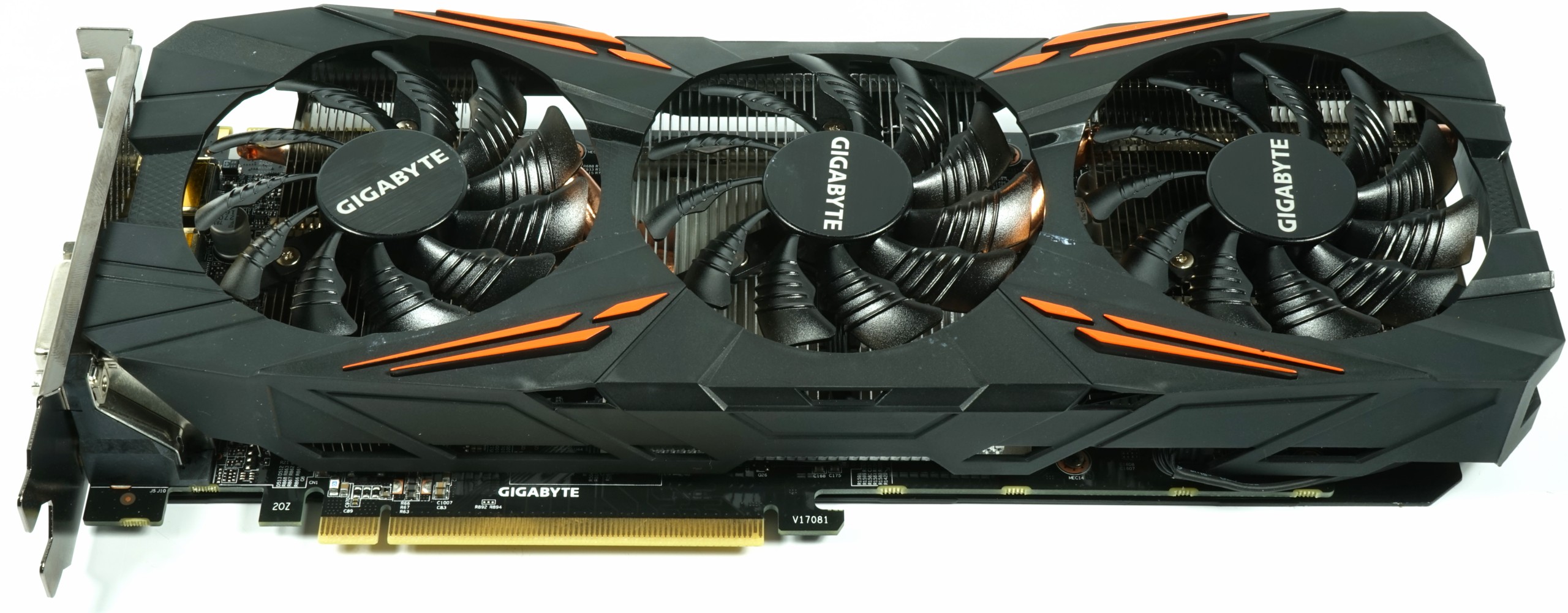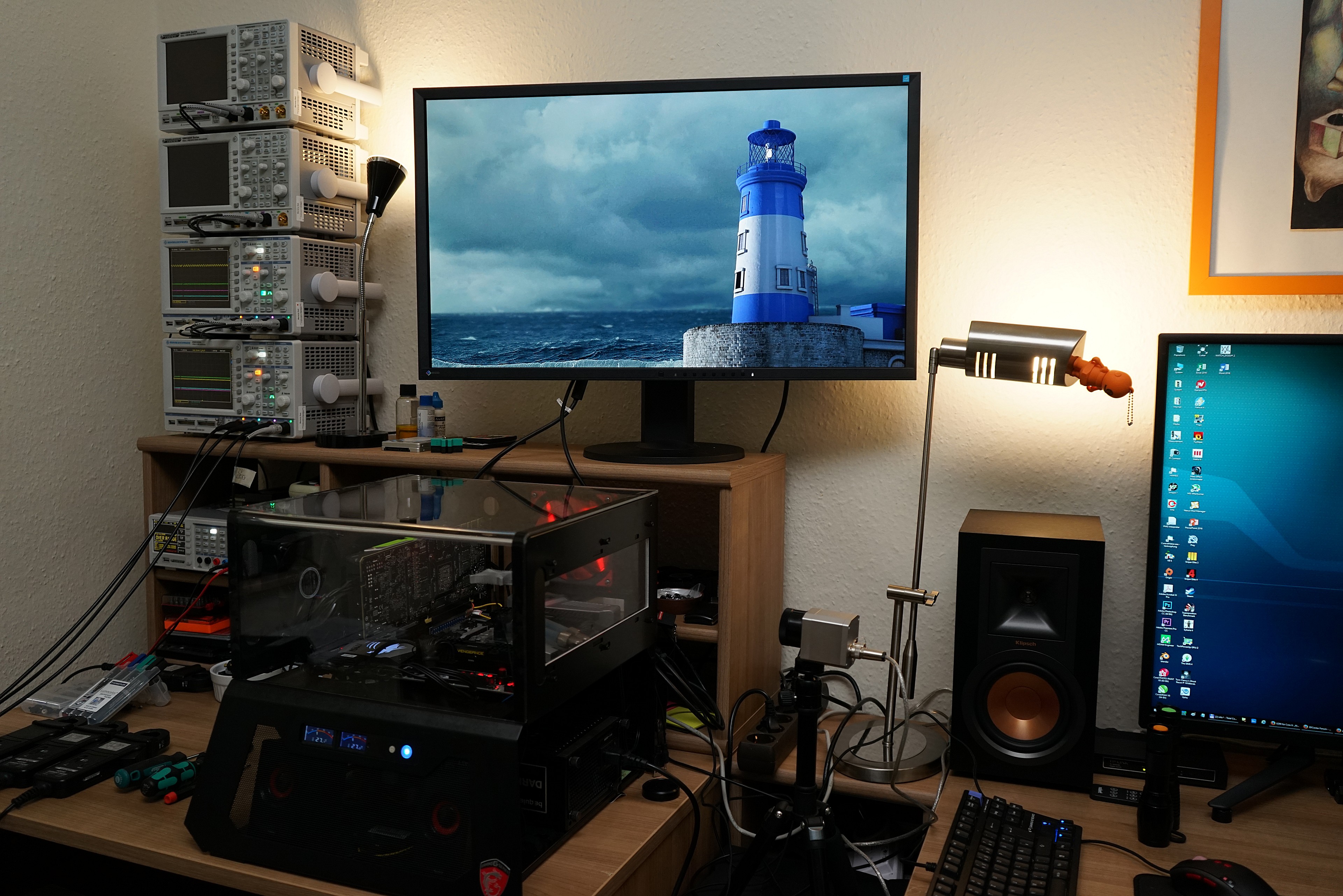Early Verdict
The general problem with all GeForce GTX 1070 Ti cards affects this model as well. Nvidia's mandated clock rates mean it doesn't matter if you buy a reference card or a fancy third-party board. The overclocking limits and factory performance are all about the same, plus or minus a few percent. Gigabyte does avoid piling on expensive gimmicks in this case. Unfortunately, a $490 price tag doesn't reflect those savings. Nevertheless, this card passes our test and will undoubtedly interest certain enthusiasts. It's not an outstanding piece of hardware, but will fit into narrow cases thanks to its dimensions.
Pros
- +
Light weight
- +
Reasonable dimensions
- +
Dual-slot form factor
- +
Only minor coil buzzing noise
- +
Backplate contributes to cooling
Cons
- -
Relatively noisy under load
- -
Not priced well relative to competition
Why you can trust Tom's Hardware
Features & Specifications
Unlike the companies that used GeForce GTX 1080 PCBs and coolers for their 1070 Ti cards, Gigabyte pulled parts from the other side of its portfolio. It instead revised the design of its GeForce GTX 1070 G1 Gaming to accommodate Nvidia's higher-end solution. Naturally, the board itself is more than ample. It's the heat sink and fan that we need to look at more closely.
Of course, we've seen the competition name their cards as if 1070 Tis were differentiated by their out-of-box performance, garnishing them with software overclocking options as a consolation prize. Gigabyte scraps the Aorus label altogether for this one, though. If it can't apply factory overclocking, it's not a flagship. Period. Seems like sound logic to us.
Since the performance of all third-party GeForce GTX 1070 Ti cards is similar, given fixed clock rates mandated by Nvidia, actual benchmark results depend on the GPU Boost frequencies each vendor can sustain. As you might imagine, then, cooling and chip quality play the most important roles. That's why we're putting our emphasis on the actual implementation of each model. To that end, a lot of equipment goes into thoroughly documenting a graphics card's behaviors.
At this point, it's not possible to reach a meaningful conclusion by comparing the performance of one card over another. The differences are too small. Therefore, we're not going to label manufacturers in our benchmarks, particularly since one of those two variables (chip quality) cannot be held constant, even between retail samples off the shelf. Just know that every GeForce GTX 1070 Ti fares similarly out of the box.
Specifications
Prior to launch, Gigabyte had an overclocked BIOS ready to go. It was initially even approved by Nvidia. As a result, around 25,000 cards shipped out from the factory with matching labels (the following two labels show the difference between our first sample and the model that eventually hit retail). If you were lucky enough to receive one of the first cards, you're probably seeing much higher frequencies than everyone else with a 1070 Ti.
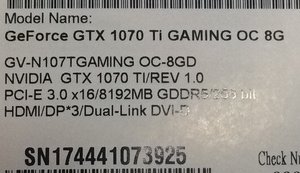
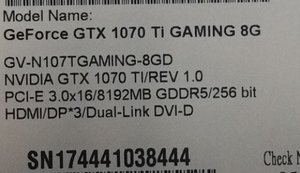
However, since Nvidia banned this first edition of the card and refused to allow the overclocked BIOS' use, we're honoring Gigabyte's request to only use the updated version of its card for our review.
Gigabyte's bundle is limited to a software DVD and manual.
Get Tom's Hardware's best news and in-depth reviews, straight to your inbox.
Exterior
The fan shroud is made of anthracite-colored matte plastic with eye-catching orange highlights. A weight of just 757g makes this one of the lighter cards we've reviewed, and that helps simplify installation in compact cases.
A total of three 80mm fans are meant to ensure sufficient airflow. It's hard to tell that those fans are on the small side just by looking at pictures of the 1070 Ti Gaming 8G, since the cooler is long and narrow.

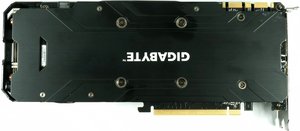
Around back, the PCB is covered with a single-piece, blackened aluminum plate with a white Gigabyte logo in the middle.
Plan for an additional 5mm of clearance for the backplate. This extra requirement means the Gigabyte GeForce GTX 1070 Ti Gaming 8G isn't particularly well-suited for multi-GPU configurations. Stability suffers without the backplate installed, so you don't want to try removing it.
Up top, that Gigabyte logo sports LED back-lighting. There's also a fan-stop indicator and an eight-pin auxiliary power connector toward the end.
From the back, this card is completely closed off. That makes sense, as the cooling fins are oriented vertically, blocking air from moving side to side and instead guiding it up (out the top) and down (towards your motherboard). But the design certainly won't help temperatures inside your case, since exhaust is recirculated.
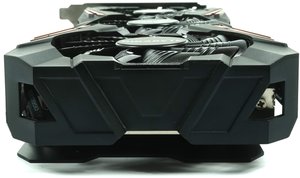
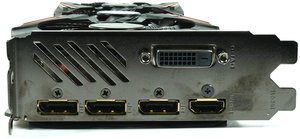
The I/O bracket features five familiar outputs, four of which can be used simultaneously in multi-monitor configurations. In addition to the single DVI connector, you get one HDMI 2.0 port (particularly useful for VR HMDs) and three DisplayPort 1.4-ready interfaces. Ventilation holes cut into the plate suggest help with exhaust, but they really serve no purpose since the fins direct air vertically.
Specifications
Since the technical specifications are required to be the same for all GeForce GTX 1070 Ti, the following table applies to all cards collectively:
| GPU | GeForce GTX 1080 (GP104) | GeForce GTX 1070 Ti (GP104) | GeForce GTX 1070 (GP104) |
|---|---|---|---|
| SMs | 20 | 19 | 15 |
| CUDA Cores | 2560 | 2432 | 1920 |
| Base Clock | 1607 MHz | 1607 MHz | 1506 MHz |
| GPU Boost Clock | 1733 MHz | 1683 MHz | 1683 MHz |
| GFLOPs (Base Clock) | 8228 | 7816 | 5783 |
| Texture Units | 160 | 152 | 120 |
| Texel Fill Rate | 277.3 GT/s | 244.3 GT/s | 201.9 GT/s |
| Memory Data Rate | 10 Gb/s | 8 Gb/s | 8 Gb/s |
| Memory Bandwidth | 320 GB/s | 256 GB/s | 256 GB/s |
| ROPs | 64 | 64 | 64 |
| L2 Cache | 2MB | 2MB | 2MB |
| TDP | 180W | 180W | 150W |
| Transistors | 7.2 billion | 7.2 billion | 7.2 billion |
| Die Size | 314 mm² | 314 mm² | 314 mm² |
| Process Node | 16nm | 16nm | 16nm |
Test System & Measurement Methods
We introduced our new test system and methodology in How We Test Graphics Cards. If you'd like more detail about our general approach, check that piece out. In this case, only the CPU, RAM, motherboard, and cooling system are different.
| Test System | |
|---|---|
| Hardware | Intel Core i7-6900K @ 4.3 GHzMSI X99S XPower Gaming TitaniumCorsair Vengeance DDR3-32001x 1TB Toshiba OCZ RD400 (M.2, System)2x 960GB Toshiba OCZ TR150 (Storage, Images)be quiet! Dark Power Pro 11, 850W Power SupplyWindows 10 Pro (Creators Update) |
| Cooling | Alphacool Eisblock XPXAlphacool Eiszeit 2000 Chiller2x be quiet! Silent Wings 3 PWMThermal Grizzly Kryonaut |
| Case | Lian Li PC-T70 with Extension Kit and Mods Configurations: Open Benchtable, Closed Case |
| Monitor | Eizo EV3237-BK |
| Power Consumption Measurement | Contact-free DC Measurement at PCIe Slot (Using a Riser Card) Contact-free DC Measurement at External Auxiliary Power Supply Cable Direct Voltage Measurement at Power Supply 2x Rohde & Schwarz HMO 3054, 500MHz Digital Multi-Channel Oscilloscope with Storage Function4x Rohde & Schwarz HZO50 Current Probe (1mA - 30A, 100kHz, DC) 4x Rohde & Schwarz HZ355 (10:1 Probes, 500MHz) 1x Rohde & Schwarz HMC 8012 Digital Multimeter with Storage Function |
| Thermal Measurement | 1x Optris PI640 80Hz Infrared Camera + PI Connect Real-Time Infrared Monitoring and Recording |
| Acoustic Measurement | NTI Audio M2211 (with Calibration File, Low Cut at 50Hz) Steinberg UR12 (with Phantom Power for Microphones)Creative X7, Smaart v.7 Custom-Made Proprietary Measurement Chamber, 3.5 x 1.8 x 2.2m (L x D x H) Perpendicular to Center of Noise Source(s), Measurement Distance of 50cm Noise Level in dB(A) (Slow), Real-time Frequency Analyzer (RTA) Graphical Frequency Spectrum of Noise |
MORE: Best Graphics Cards
MORE: Desktop GPU Performance Hierarchy Table
MORE: All Graphics Content

Igor Wallossek wrote a wide variety of hardware articles for Tom's Hardware, with a strong focus on technical analysis and in-depth reviews. His contributions have spanned a broad spectrum of PC components, including GPUs, CPUs, workstations, and PC builds. His insightful articles provide readers with detailed knowledge to make informed decisions in the ever-evolving tech landscape
-
Cryio I'm still mostly impressed how the Vega64 is universally faster than 1080, same for Vega56 vs 1070.Reply -
derekullo Reply20526514 said:I'm still mostly impressed how the Vega64 is universally faster than 1080, same for Vega56 vs 1070.
The Geforce 1080 beats the Vega64 in Tom Clancy's Ghost Recon Wildlands at 2560x1440.
The Vega64 is also a 295 watt tdp card versus the 180 watt Geforce 1080.
A 60% increase in TDP to be 0 - 12% better is not very efficient.
https://www.techpowerup.com/gpudb/2839/geforce-gtx-1080
https://www.techpowerup.com/gpudb/2871/radeon-rx-vega-64
For completeness, the Geforce 1080 Ti is a 250 watt card.
https://www.techpowerup.com/gpudb/2877/geforce-gtx-1080-ti
On the other hand, Vega56/64 are both awesome monero miners even taking their 295 watt tdp into account.
https://whattomine.com/coins?utf8=%E2%9C%93&adapt_q_280x=0&adapt_q_380=0&adapt_q_fury=0&adapt_q_470=0&adapt_q_480=0&adapt_q_570=0&adapt_q_580=0&adapt_q_vega56=1&adapt_vega56=true&adapt_q_vega64=0&adapt_q_750Ti=0&adapt_q_1050Ti=0&adapt_q_10606=0&adapt_q_1070=0&adapt_q_1080=0&adapt_q_1080Ti=0ð=true&factor%5Beth_hr%5D=36.5&factor%5Beth_p%5D=210.0&grof=true&factor%5Bgro_hr%5D=38.0&factor%5Bgro_p%5D=190.0&x11gf=true&factor%5Bx11g_hr%5D=10.5&factor%5Bx11g_p%5D=230.0&cn=true&factor%5Bcn_hr%5D=1850.0&factor%5Bcn_p%5D=190.0&eq=true&factor%5Beq_hr%5D=440.0&factor%5Beq_p%5D=190.0&lre=true&factor%5Blrev2_hr%5D=13000.0&factor%5Blrev2_p%5D=190.0&ns=true&factor%5Bns_hr%5D=290.0&factor%5Bns_p%5D=160.0&lbry=true&factor%5Blbry_hr%5D=260.0&factor%5Blbry_p%5D=210.0&bk2bf=true&factor%5Bbk2b_hr%5D=1900.0&factor%5Bbk2b_p%5D=230.0&bk14=true&factor%5Bbk14_hr%5D=2600.0&factor%5Bbk14_p%5D=210.0&pas=true&factor%5Bpas_hr%5D=1350.0&factor%5Bpas_p%5D=230.0&skh=true&factor%5Bskh_hr%5D=36.0&factor%5Bskh_p%5D=210.0&factor%5Bl2z_hr%5D=420.0&factor%5Bl2z_p%5D=300.0&factor%5Bcost%5D=0.1&sort=Profitability24&volume=0&revenue=24h&factor%5Bexchanges%5D%5B%5D=&factor%5Bexchanges%5D%5B%5D=abucoins&factor%5Bexchanges%5D%5B%5D=bitfinex&factor%5Bexchanges%5D%5B%5D=bittrex&factor%5Bexchanges%5D%5B%5D=bleutrade&factor%5Bexchanges%5D%5B%5D=cryptopia&factor%5Bexchanges%5D%5B%5D=hitbtc&factor%5Bexchanges%5D%5B%5D=poloniex&factor%5Bexchanges%5D%5B%5D=yobit&dataset=Main&commit=Calculate
-
danielh1949 Stacking 4 Oscopes on top of a high shelf? are you serious? please reconsider, your work is worth reading.Reply -
FormatC Reply
What's the problem? Haven't you ever been in a lab before? The parts can be stacked and this is provided for by the manufacturer. Besides, everything's screwed down, don't worry. I need short signalling pathways to connect the scopes to each other, there are not many possibilities left. And - between you and me: when I'm standing in front of it, the top scope is barely at eye level. This is the art of photography, not a high shelf :D20526949 said:Stacking 4 Oscopes on top of a high shelf? are you serious? please reconsider, your work is worth reading.
If you don't have any problems, you can build your own... ;)
-
danielh1949 Reply
Just concerned about your safety, and I've built enough of my own; but I see from your picture that I need not be concerned. Nice setup, as long as it's safe. I look forward to interesting reading. I'd especially like waveform comparison of the current PCI with the new bus they're considering as the replacement. The whole waveguide multilayer PC board is nearly as interesting as Walsh codes. Merry Christmas and Happy New Year. Hope it's better than this one was. Old Lang Syne is gaining new meaning to me. Dan20529267 said:
What's the problem? Haven't you ever been in a lab before? The parts can be stacked and this is provided for by the manufacturer. Besides, everything's screwed down, don't worry. I need short signalling pathways to connect the scopes to each other, there are not many possibilities left. And - between you and me: when I'm standing in front of it, the top scope is barely at eye level. This is the art of photography, not a high shelf :D20526949 said:Stacking 4 Oscopes on top of a high shelf? are you serious? please reconsider, your work is worth reading.
If you don't have any problems, you can build your own... ;)
-
FormatC Have you ever been to the lab in China? What is the screw for the German and the glue for the American is the cable tie for the Chinese. It's all very optimistic (ok, it looks so), but it's (mostly) holding up well. :DReply
I wish you also a happy new year and have a nice time. :) -
danielh1949 Reply20533302 said:Have you ever been to the lab in China? What is the screw for the German and the glue for the American is the cable tie for the Chinese. It's all very optimistic (ok, it looks so), but it's (mostly) holding up well. :D
I wish you also a happy new year and have a nice time. :)
My uncle, Herr Professor, sent me German Erektor Sets for my earliest birthdays (or so I seem to remember), Your question brought to my mind a vision of an erector set tower held together by wire ties.:pt1cable: I guess it would be good for an earthquake, although I would not like to be on it at that time.
